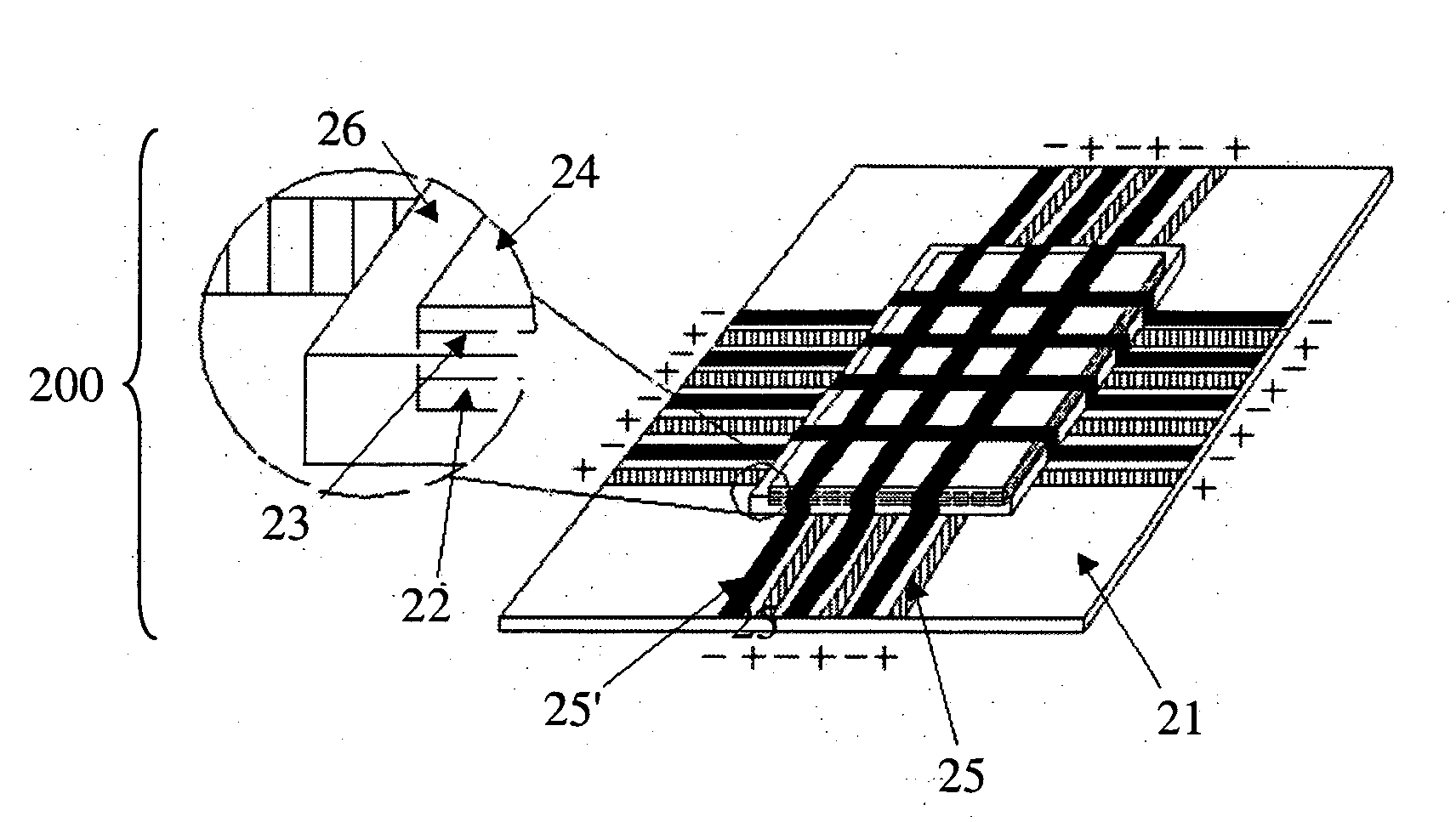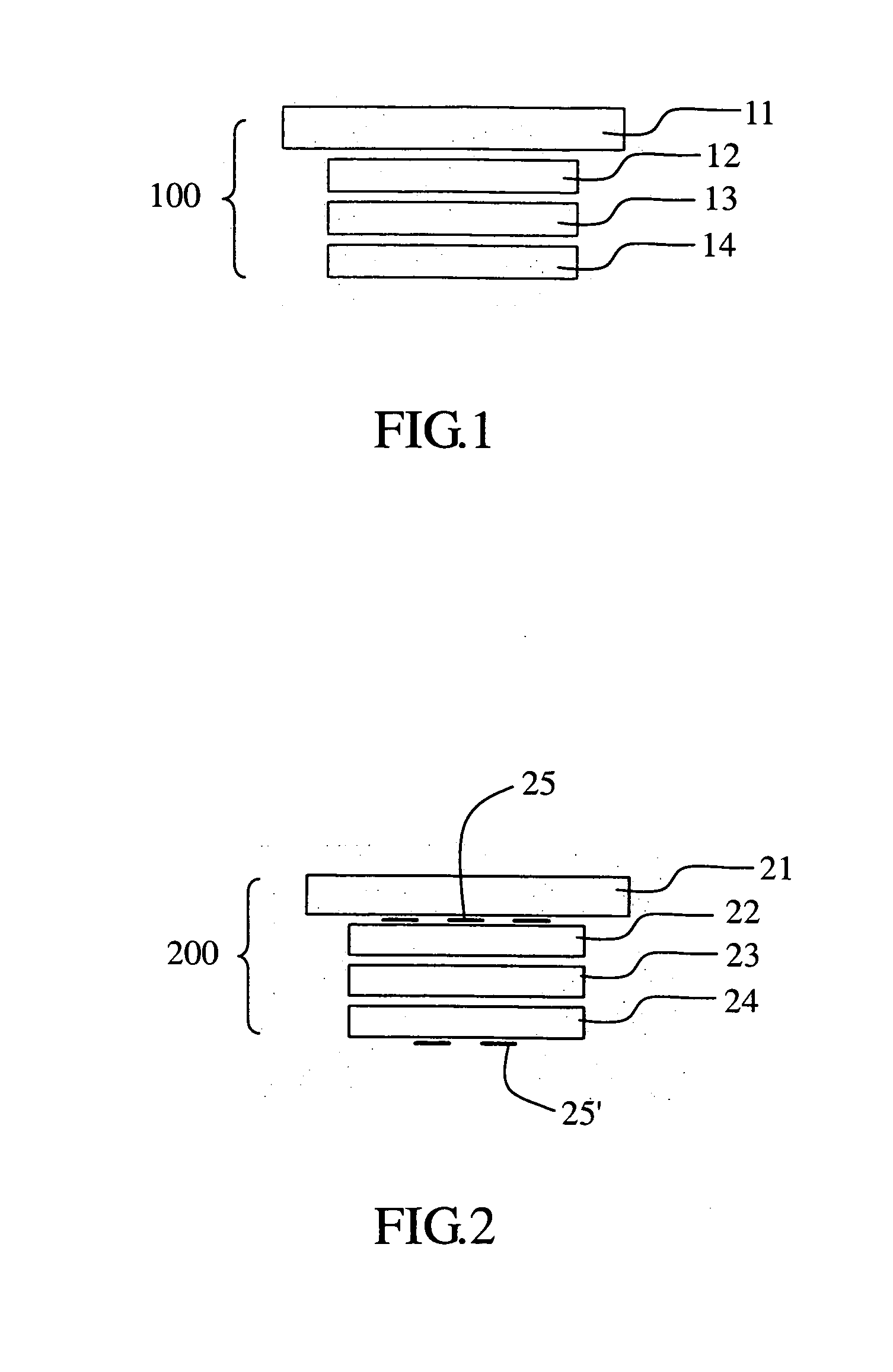Electrochromic film
a technology of electrochromic film and electrochromic film, applied in non-linear optics, instruments, optics, etc., can solve the problems of insufficient market demand for inorganic electrochromic devices, inability to meet the needs of consumers, and high production cost of inorganic electrochromic depositing processes, so as to achieve the electrochromic effect and facilitate the adhesion of electrochromic films
- Summary
- Abstract
- Description
- Claims
- Application Information
AI Technical Summary
Benefits of technology
Problems solved by technology
Method used
Image
Examples
example 1
The Preparation of the Electrochromic Film of the Present Invention (I)
[0044]A layer of PEDOT / PSS coating was applied on a 5×6 cm2 PET substrate which was then dried to form a transparent conducting layer. The solid polymer electrolyte was prepared as follows: 0.1 g lithium trifluomethanesulfonate and 1 g PEO were vacuum dried at 100° C. and 50° C. for 24 hours, respectively, The powders were then dissolved in 6 cc Propylene Carbonate solvent and stirred and heated to obtain a clear liquid electrolyte. The electrolyte was then coated on an area of 5×5 cm2 PET conducting film, the rest 5×1 cm2 was reserved as an electrode, the film was further dried in the vacuum oven at 120° C. for 8 hours. Next, a layer of PEDOT / PSS coating was coated on the top of the electrolyte layer and was dried in an oven at 100° C. for an hour. This layer would serve as the second electrode. When the electrochromic film was electrically connected with a driving force of 3 to 5 volts D.C. the area of 5×5 cm2 ...
example 2
The Preparation of the Electrochromic Film of the Present Invention (II)
[0045]The PEDOT / PSS coating layer was designed as shown in FIG. 5A. The polymer electrolyte was prepared as follows: 0.05 g lithium trifluomethanesulfonate and 1 g PEO were dried respectively at 100° C. and 50° C. for 24 hours, then dissolved the powder in 6 cc THF solvent and stirred to obtain clear a liquid electrolyte. The electrolyte was then coated on the top of the specific pattern as shown in FIG. 5B which was then dried at the room temperature for 2 hours. When the electrochromic film was electrically connected with a driven voltage of 3 to 5 volts D.C., the cathodic electrochromic layer and the anodic electrochromic layer would color immediately.
example 3
The Preparation of the Electrochromic Film of the Present Invention (III)
[0046]A 4×4 cm2 portion of 7.5×5 cm2 PET substrate was coated with PEDOT / PSS coating which was then dried to form a transparent conducting layer. The solid polymer electrolyte was prepared as follows: 0.1 g lithium perchlorate and 1 g PMMA were vacuum dried at 100° C. and 50° C. for 24 hours, respectively, The powders were then dissolved in 10 cc Propylene Carbonate solvent and were stirred and heated to obtain a clear liquid electrolyte. An electrolyte thin layer of 4.5×3.5 cm2 was then coated on top 4×3 cm2 of PEDOT / PSS coating layer, the rest 4×1 cm2 of the PEDOT / PSS coating were reserved as an electrode. The whole film was further dried in the vacuum oven at 120° C. for 8 hours.
[0047]A 20 nm thin layer of silver layer was sputtered on the top of the electrolyte layer and the bare part of PET substrate. In the RF magnetron sputtering process, care must be taken not to overlap the silver layer with PEDOT / PSS ...
PUM
 Login to View More
Login to View More Abstract
Description
Claims
Application Information
 Login to View More
Login to View More - R&D
- Intellectual Property
- Life Sciences
- Materials
- Tech Scout
- Unparalleled Data Quality
- Higher Quality Content
- 60% Fewer Hallucinations
Browse by: Latest US Patents, China's latest patents, Technical Efficacy Thesaurus, Application Domain, Technology Topic, Popular Technical Reports.
© 2025 PatSnap. All rights reserved.Legal|Privacy policy|Modern Slavery Act Transparency Statement|Sitemap|About US| Contact US: help@patsnap.com



